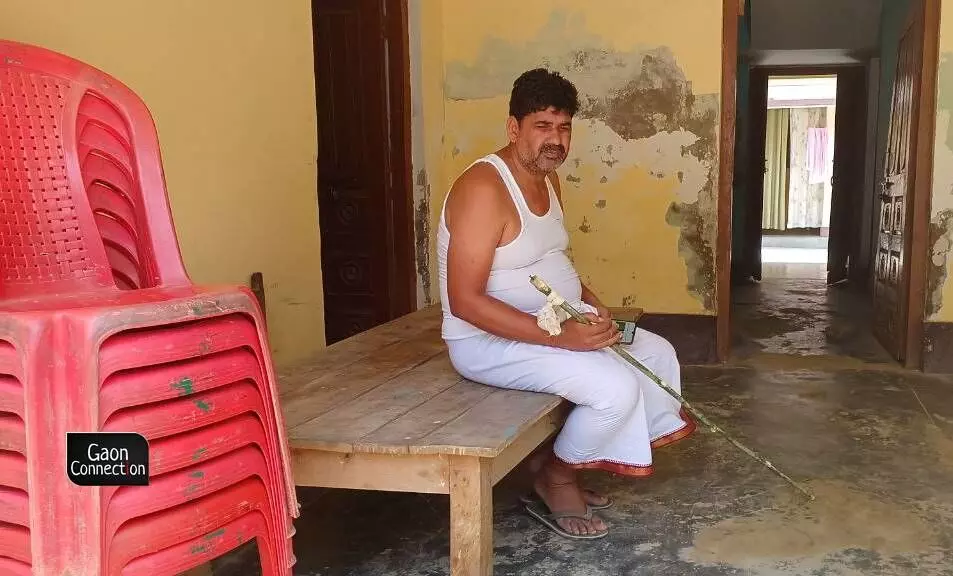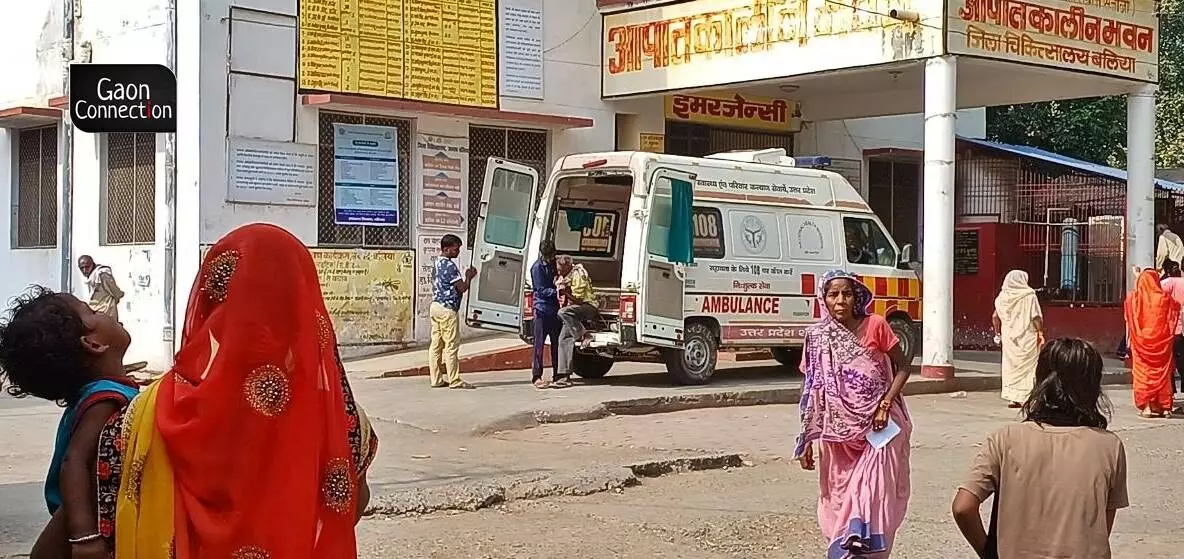Ballia, Uttar Pradesh
It’s been four days since his father died but 42-year-old Satyajit Singh hasn’t been able to come to terms with his absence in the house.
‘Pitaji bas ikdum se kho gaye’ [It’s as if he just disappeared] — Satyajit repeats the phrase whenever he is asked about what happened on the night of June 17.
On that fateful night, the turmoil in the Singh household was unprecedented. “Pitaji was visibly anxious… He wasn’t able to breathe easily and was perspiring heavily. We tried to soothe him by using a hand fan but he remained extremely restless,” Satyajit, a resident of Haripur village in Ballia, told Gaon Connection as he narrated the last moments of his 65-year-old father Abhimanyu Singh.
“He went to bathe at least thrice that night but still kept moving around anxiously. I had never seen him so disturbed before. A few minutes later, he sat down and fell on his bed and became unconscious,” the grief-stricken son added. By the time Satyajit took his father to the district hospital Ballia (after first taking him to a jhola chaap), the latter had died.

Satyajit Singh is yet to come to terms with his father’s demise.
As per weather records, Ballia district in Uttar Pradesh had reported a maximum temperature of 45 degrees Celsius on June 17, and a minimum temperature of 32 degrees Celsius. A heat wave had been sweeping across several states in north India with the India Meteorological Department (IMD) issuing a series of warnings and weather advisories. It is only now that rains have offered some respite for the extreme heat.
The southwest monsoon this year is delayed, and the heat and humidity together are adding to the heat stress. In the past couple of days, a series of deaths have been reported in Uttar Pradesh and Bihar. Unconfirmed reports claim over 100 people have died in these two states.
#GaonConnection is in #Ballia, Uttar Pradesh where 68 people have reportedly died and over 500 hospitalised in the past couple of days. The flow of patients continues at District Hospital Ballia. Follow @GaonConnection as we investigate these recent deaths.
: @Mirzapuriy pic.twitter.com/yeLegyX4zE
— Gaon Connection English (@GaonConnectionE) June 20, 2023
Authorities have denied any link between these deaths and the heat wave. An investigation is already underway in Ballia, Uttar Pradesh, which had reported the highest death toll.
“The situation is normal in our district hospital and we have all the wherewithal to handle the patients. The entire clinical burden in the Ballia district is concentrated in the district hospital which has led to the high rate of hospitalisations” SK Yadav, the chief medical superintendent in Ballia, told Gaon Connection today, June 21 morning.
“The private hospitals are not as good in the district and the facilities in the district hospital are far better. The patients find no better option but to come here for any serious illnesses,” the official added.
“जिला अस्पताल बलिया में हमेशा से मरीजों की संख्या ज्यादा होती है, सारे जिले से लोग आते हैं। हमारे यहाँ सारी सुविधाएँ हैं।” – एसके यादव, सीएमएस, बलिया, यूपी
जल्द ही गाँव कनेक्शन पर देखिए बलिया से ग्राउंड रिपोर्ट pic.twitter.com/5u6SuCLk9W
— GaonConnection (@GaonConnection) June 21, 2023
Although initially, Diwakar Singh, the then chief medical superintendent in the Ballia district had attributed these deaths to the prevailing heat wave conditions, but following his ouster from his post on June 17, the district magistrate soon after mentioned that the deaths were because of a variety of reasons other than the heat wave conditions in the region.
“There are many reports mentioning that people have died due to heat wave conditions in Ballia. There is no concrete evidence to attribute the deaths to the heat wave. The chief medical superintendent has been removed from his post for issuing statements without concrete proof,” Ravindra Kumar, district magistrate, told the press on June 19.
Meanwhile, just three days before Abhimanyu Singh collapsed and died, Harinder Kumar Singh, a 45-year-old resident of Bhojpur village in Ballia too died under mysterious conditions on June 14.

A combination of heat and humidity is extremely risky especially in a rural setting where instant arrangements for oral rehydration and medical help are not as good as in the urban areas.
“It was just another day. He just had his lunch, went to the village pond to spend some time near water and while he was returning home, he had some phulki [a popular street food] on the way. Upon reaching home, he just collapsed and died,” Shail Kumari, Harinder’s sister-in-law, told Gaon Connection. “It was too hot that day. We just don’t know how to process his death,” she added.
Also Read: Amid rising heatwaves, ‘Cool-Roofs’ can save lives. Here’s how
Grija Shankar Singh, the elder brother of Harinder, repeated the same story that his younger brother had just taken a bath and went out for a short walk after lunch following which he returned home and died.
“It is sad. He didn’t have any kids. He is only survived by his wife who is in shock right now,” said Girija Shankar.

Girija Shankar Singh (right), the elder brother of Harinder Singh.
Spate in deaths a ‘coincidence’, probe underway to investigate cause
Meanwhile, when reporters asked KN Tiwari, the director of the department of medical health and family welfare in Ballia about the recent deaths amidst the heatwave conditions, the official went on to term the rise in morbidity as a coincidence.
“The rise in the number of deaths at the district hospital could also be a coincidence but to link it with the heatwave would not be appropriate. Also, the district hospital serves a large area in Ballia and the private hospitals here are not as equipped as this government hospital. That is also a reason behind the high death toll in the last few days,” replied Tiwari.
The senior official also mentioned that the medical teams were investigating the cause of these deaths and the blood and urine samples of the patients were constantly being tested for a variety of pathogenic illnesses.
“It is very much possible that some other disease might go unnoticed while the media and the people in general are attributing these deaths to the heatwave. We are thoroughly investigating these cases for any infection which might later lead to a bigger outbreak,” he added.
Rural Residents at Risk
Satish Gadi, a Gurgaon-based physician who is retired from the Indian Army and has served as the Chief Medical Director of the Indian Railways, explained how heat affects the human body and can also turn fatal. According to the public health expert, extreme heat can be injurious in two ways — heat stroke and heat exhaustion.
“When the extreme heat is coupled with high humidity in the atmosphere, the extent of dehydration in the body is very dangerous. It can quickly thicken the blood, reduce the electrolytes in the body, damage blood cells and unless quickly replenished, the person is prone to severe dehydration and even death,” Gadi said.
“But in case of heat stroke, the body gets so hot that it becomes difficult for the patient to be able to sustain life processes which keep them alive. In such cases, the body temperature needs to be brought down as soon as possible. Even ice water or ice can also be used to cold down the body,” he added.
The doctor underlined that a combination of heat and humidity is extremely risky especially in a rural setting where instant arrangements for oral rehydration and medical help are not as good as in the urban areas.
“In heat wave conditions, air conditioning indoors is not a luxury but a need. Unfortunately, we are a developing country where people especially in the rural areas are not equipped with the resources needed to help prevent the damage to health caused by the heat waves,” Gadi told Gaon Connection.
The deaths in Ballia district have earned the ire of the opposition parties. Narad Rai, a former state minister in the Samajwadi Party told Gaon Connection that the government is on a damage control mode while innocent lives are being lost relentlessly.
“There is a direct link between these deaths and the heatwave. The government is just trying to manipulate people. We have submitted a list of measures desperately needed to defuse the situation,” said Rai.
Meanwhile, in wake of the heatwave conditions prevailing in the state, Uttar Pradesh Chief Minister Yogi Adityanath has instructed the authorities to ensure that there were no unnecessary power cuts in the state. Adityanath also mentioned that there should be a provision to purchase more electricity for the state government if needed. However, villagers complain they are suffering seven to eight hours of daily power outages.
Written by Pratyaksh Srivastava




















